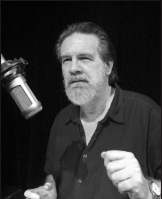By Will McKinley
Dan Bianchi looks like he’s ready to bump somebody off. With his long leather coat, slicked back hair and Noo Yawk growl, the fifty-something greybeard appears to have just stepped out of the pulp fiction he grew up reading.
In reality, the longtime Village resident is the brains (and producer, sound designer and graphic artist) behind “The H.G. Wells Science Fiction Festival,” a series of four classic stories adapted by Bianchi and presented as live audio dramas at the 59E59 Theater.
This weekend, in honor of what he calls the “the high holy days of Halloween,” Bianchi’s RadioTheatre troupe will be presenting all four shows each day — “The War of the Worlds,” “The Invisible Man,” “The Island of Dr. Moreau” and “The Time Machine.”
Bianchi took a break from his busy schedule to talk to me for a long time about a lot of things.
WILL McKINLEY: Where are you from?
DAN BIANCHI: My family is from what is now fashionably called Chelsea. In the old days it was where the Irish lived. Legs Diamond and the Irish gangsters back then, they were all family friends.
Was your family in the mob?
I’m pretty sure my grandfather ran booze during Prohibition. Owney Madison ran the whole West Side. He was my mother’s godfather.
How long have you lived in the Village?
I lived for three years in Sheridan Square and then 25 years on Waverly Place.
What are the biggest changes you’ve noticed in the neighborhood over the last thirty years?
It became a safer place. I remember coming home late every night from the theater and the side streets were dark and lonely. Several times I had to run or stand my ground with a makeshift weapon, such as a broken broom handle. There were street brawls in the middle of the night and the St. Vincent’s emergency ward was always filled with victims of violence.
How has the Village arts scene changed?
During the 1980s when real estate quadrupled, the quaint shops, home cooking restaurants and artists’ hangouts that made the Village famous suddenly disappeared. Now, the tour busses go by every 10 minutes as guides point out where these famous haunts used to be. Most of the younger generation who can afford the high rents aren’t really interested in banding together to fight the establishment. They are the establishment.
How did you get your start in show business?
I started out as a painter when I was 17 and had my first solo exhibition. In the late ’60s into the ’70s, I ran around in the rock world, touring with Hendrix, Clapton, The Band and Miles Davis. Either I was driving a bus, designing psychedelic posters, or filling in on guitar for some zonked out band member. I first directed live theater in New York back in early ’70s. Three years ago, I came up with RadioTheatre.
How did you come up with the idea?
Live theater always does the pulp fiction field — horror, sci-fi, action — as parody or farce. It’s always, “Let’s dress vampires up in tights and sing songs.” Obviously you can’t compete with Hollywood movies. You can’t put real monsters on stage. So I said, “Let’s strip it down and bring it back to where theater all started — in the dark, around one light — a camp fire, or candle, whatever it is.” That’s what we can offer, that they can’t.
Were you inspired by the classic radio of the 1940s?
I grew up in the ‘50s. By then the Golden Age of Radio was long gone. I remember the old TV shows, like “Thriller” with Boris Karloff, “The Twilight Zone” and “Alfred Hitchcock Presents.” I remember the sound of those shows, because I had to be in bed, but the TV would be on in the other room.
“The War of the Worlds” has been done a million times. Do we really need another version of it?
Well, that’s our biggest selling show. It’s already sold out for the whole run.
So apparently the answer is “Yes.”
The four H.G. Wells stories that we’re doing have never gone out of print since the 1890s. They mean something to our society. Hollywood is still making $100 million movies from these titles.
Most of your shows have been done at Downtown theaters. Why did you move to Midtown for this one?
Expense. Shows average $15-20,000 to put up in these little places. You can sell out every night and you’re never going to break even. And now we get the Midtown crowd, the tourists who are afraid to go Downtown. They’re still thinking of the 1972 version of the Lower East Side.
“The H.G. Wells Science Fiction Festival” runs through November 4 at 59E59 Theater, 59 East 59th St., 212-279-4200, radiotheatrenyc.com.







































